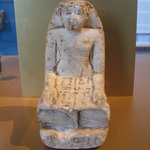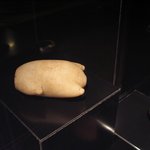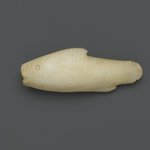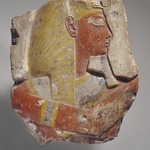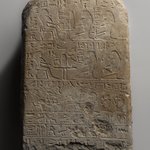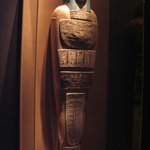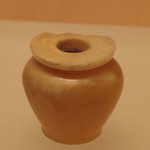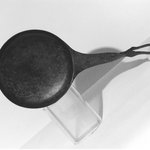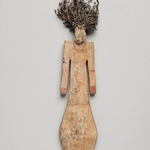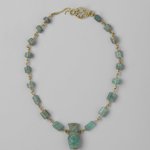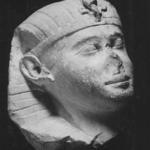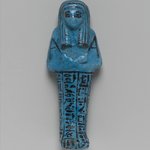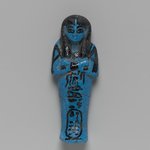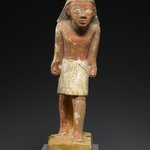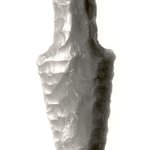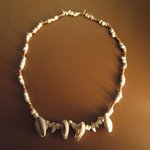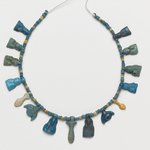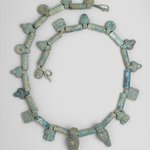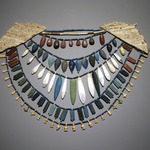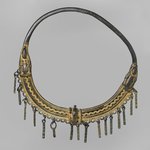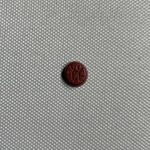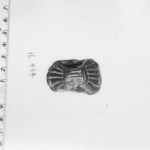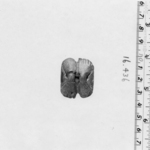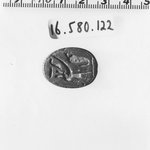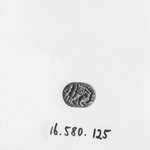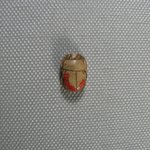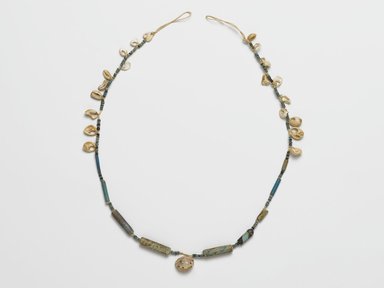
Necklace
Egyptian, Classical, Ancient Near Eastern Art
Necklaces that include shells are known from earliest times. They may have been purely decorative, or perhaps they had some unknown meaning for the Egyptians. But royal women had nerita-shell-shaped amulets made from gold.
MEDIUM
Faience, shell (marine Cypraea moneta and Xeropicta vestalis)
DATES
ca. 2008–1630 B.C.E.
PERIOD
Middle Kingdom
DIMENSIONS
1/2 x 1/4 x 19 1/8 in. (1.3 x 0.6 x 48.6 cm) (show scale)



COLLECTIONS
Egyptian, Classical, Ancient Near Eastern Art
ACCESSION NUMBER
26.167
CREDIT LINE
Gift of the Egypt Exploration Society
CATALOGUE DESCRIPTION
Single strand necklace of blue faience beads, the small ones circular, the larger tubular. The colors vary from gray to vivid blue, one bead being marked with black manganese. The shells of a small sea animal, presumably a species of snail are scattered at the ends of the necklace with one large shell in the center.
The small shells that are cut into slices have been identified as a marine cowry, Cypraea moneta (widely used as currency for centuries) and the large central shell has been identified as coming from a land snail, Xeropicta vestalis.
Condition: A few beads are broken.
MUSEUM LOCATION
This item is not on view
CAPTION
Necklace, ca. 2008–1630 B.C.E. Faience, shell (marine Cypraea moneta and Xeropicta vestalis), 1/2 x 1/4 x 19 1/8 in. (1.3 x 0.6 x 48.6 cm). Brooklyn Museum, Gift of the Egypt Exploration Society, 26.167. Creative Commons-BY (Photo: Brooklyn Museum, 26.167_PS2.jpg)
IMAGE
overall, 26.167_PS2.jpg. Brooklyn Museum photograph, 2006
"CUR" at the beginning of an image file name means that the image was created by a curatorial staff member. These study images may be digital point-and-shoot photographs, when we don\'t yet have high-quality studio photography, or they may be scans of older negatives, slides, or photographic prints, providing historical documentation of the object.
RIGHTS STATEMENT
Creative Commons-BY
You may download and use Brooklyn Museum images of this three-dimensional work in accordance with a Creative Commons license. Fair use, as understood under the United States Copyright Act, may also apply.
Please include caption information from this page and credit the Brooklyn Museum. If you need a high resolution file, please fill out our online application form (charges apply).
For further information about copyright, we recommend resources at the United States Library of Congress, Cornell University, Copyright and Cultural Institutions: Guidelines for U.S. Libraries, Archives, and Museums, and Copyright Watch.
For more information about the Museum's rights project, including how rights types are assigned, please see our blog posts on copyright.
If you have any information regarding this work and rights to it, please contact copyright@brooklynmuseum.org.
RECORD COMPLETENESS
Not every record you will find here is complete. More information is available for some works than for others, and some entries have been updated more recently. Records are frequently reviewed and revised, and we welcome any additional information you might have.



